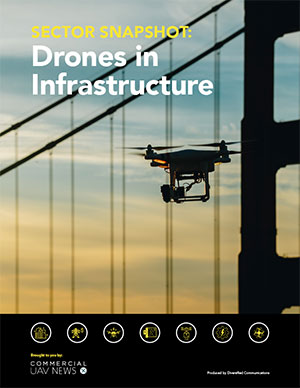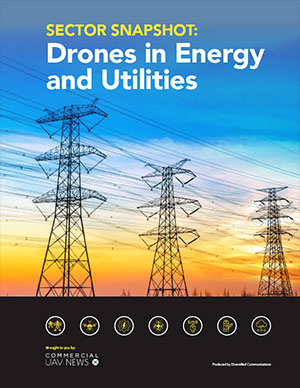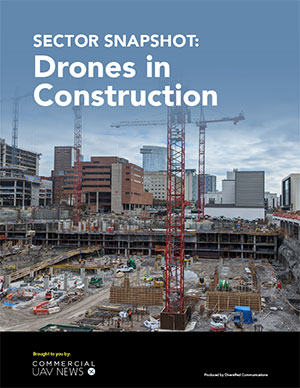Commercial UAV operators have long viewed beyond visual line of sight (BVLOS) flights to be the key to unlocking drones’ full potential, but proposed new regulations from the FAA have the sector on edge. A fast-paced public comment period on the FAA’s Part 108 Notice of Proposed Rulemaking (NPRM) is seen as critical for shaping final BVLOS regulations that will either expand or restrict UAV flying.
What is at stake, say many UAV players, is the continued viability of commercial and public-service drone operations in the United States.
While drone operators are eager to move the FAA in a more permissive direction through public comments due by October 6, other sectors are pushing the agency to be even more restrictive than the NPRM outlines, highlighting the challenge UAV operators face in influencing the final Part 108 rule.
Indeed, operators of hot air balloons—a form of flight dating back to 1783—are raising serious objections to the NPRM.
The clash between old and new was apparent in early Part 108 NPRM public comments being submitted to the FAA, demonstrating the range of interested parties—far beyond the drone sector—that aim to influence the agency's final rulemaking. Nicole Hanson, secretary of the Gateway Aerostatic Association representing the hot air balloon industry, expressed “many concerns” about the Part 108 NPRM.
“I highly believe this rule as written presents a huge and unacceptable safety risk to hot air balloon pilots, our passengers and all other users of low-level airspace,” Hanson wrote in a public comment submitted to the FAA. “I am concerned not only for hot air balloons, but power parachutes, paramotors, hangliders, skydivers, the list goes on.”
Hanson said hot air balloons often fly at the “exact altitudes Part 108 drones are to be flying within,” adding: “Do you know what will happen to a fabric envelope if it is hit and sliced by a drone? The balloon envelope will get a huge or multiple holes, lose heat, and begin to rapidly descend depending on the size of the damage and will require an immediate uncontrolled emergency landing.”

Drone operators face the burden of convincing the FAA that BVLOS UAV operations do not pose an undue safety hazard to previous generations of aircraft or people and infrastructure on the ground. While there have long been complaints about Part 107 regulations that have governed drone operations in the US since 2016—including its clunky BVLOS waiver system—there is serious concern among drone operators that Part 108, as written, would be a step backwards.
“A lot can change from where we are in a proposal to a final rule,” Scott Shtofman, the associate vice president and counsel for regulatory affairs for the Association for Uncrewed Vehicle Systems International, told Commercial UAV News. “The public comment period is a good opportunity for us and our members to pick the NPRM apart, point to what we like, point to what we don't like, point to what's missing and what needs to be changed …The FAA is really focused on risk and safety, so they're looking at air risk and ground risk.”
Drone Service Providers Alliance CEO Vic Moss predicted dire consequences for drone operators unless the UAV sector can convince the FAA to make significant changes to the Part 108 NPRM. For small operators such as photographers and “95 percent of the drone companies out there, the NPRM as written absolutely destroys any possibility of flying under BVLOS,” he told Commercial UAV News.
Autonomous vs. Piloted
In particular, Moss points to the NPRM’s heavy emphasis on autonomous drone operations that he believes will preclude manual, remote-piloted BVLOS flights.
“Only fully automated flights are allowed under Part 108,” he explained. “If you use a controller to fly, you can't fly under 108 as written. I need to be able to take over the drone if something goes wrong or I need to fly it back or whatever—I want to be able to take over the drone. And you cannot do that under 108. You can't take physical control of the drone. If I'm chasing construction equipment 3,000 feet away, which I can legally do [under a Part 107 waiver], I can no longer legally do it if the NPRM is finalized as written.”
Drone industry representatives in Washington, D.C., are pressing UAV operators to submit detailed comments en masse to influence the FAA’s final Part 108 rule.
“Submitting feedback to the FAA by the [Oct. 6] deadline is critical,” Commercial Drone Alliance Policy Director Liz Forro told Commercial UAV News. “The future of the drone industry depends on it. The proposal conflicts with many of the approvals that both commercial and public safety operators are flying under today, so it’s important for this community to make its voice heard. The final rule will only succeed if it reflects real-world operator insights.”
Real-world operations, including public safety uses such as firefighting, often require a level of manual maneuvering—allowed under many Part 107 waivers—that may not be allowed under Part 108.
“I think there's room for people [making public comments to the FAA] to suggest more manually operated or piloted operations under Part 108,” Shtofman said. “But as it's written right now, there's not a huge recognition for that. The plan is that the drones are doing a lot of strategic deconfliction before they take off. They're talking to each other via the systems and services that they use, and the expectation is that they're pretty much sticking to an accepted or planned route. And it's not about, 'We're using the drone for a commercial purpose, and we're flying in a specific area,' but where exactly we're going to be at what specific time is not that definite.”

He added: “With first-responder operations [being an example], there's an opportunity for those who want to have more manual operations in BVLOS to explain to the FAA how that would work, what the safety use cases are, and why the FAA should approve that on a larger scale.”
Bill Irby, CEO of drone and UAV systems provider EagleNXT, said he believes the final rule will allow for manual operations.
“I don't think there's going to be a limit on pilots operating the drone, but there may be some autonomous functionality that's required regarding aircraft detection and maneuvering,” he told Commercial UAV News. “But I don't know what the final rule is going to be.”
Part 108 Permit Restrictions
Another point of concern for drone operators is the permitting system the FAA proposes for a wide range of BVLOS operations. Large-scale operators, such as those providing extensive package delivery services, would receive certificates—similar to FAA approval for airlines—under which the agency would provide oversight and require safety management systems and training programs to be put in place by the operating company.
But most BVLOS operations under Part 108 would require permits approved on a case-by-case basis. This could potentially be even more cumbersome than the FAA’s current Part 107 waiver program, which has allowed for a variety of BVLOS flying in recent years. While the FAA said in a fact sheet on the NPRM that the Part 108 permits could be issued “promptly,” UAV operators are skeptical.
“The NPRM’s proposal to require FAA review and approval for every area of operations is impractical and counterproductive to the stated goal of making BVLOS operations routine,” stated a public comment submitted by a “coalition of commercial and recreational UAS operators” that includes the Drone Service Providers Alliance.
The submission added: “If each operational area requires manual FAA review, the process effectively becomes another waiver system, precisely the inefficiency this rulemaking is meant to replace. Instead, the FAA should publish clear, objective criteria for determining acceptable areas of operation. This would allow operators to self-assess and demonstrate compliance without an individualized approval process, while still ensuring that all operations meet a consistent safety standard. Removing the need for case-by-case approvals is critical if the FAA intends for BVLOS operations to scale beyond a small number of waivered flights.”
The permitting system, as proposed in the Part 108 NPRM, is “a big shift of workload onto the operator [to provide documents to the FAA] versus the FAA putting restrictions on what the operators can and can't do,” Shtofman said. Because there have been waivers approved for a wide range of BVLOS operations in recent years, the FAA should have the information it needs to put operating parameters in the final rule rather than a case-by-case permitting system, he added.
“What we want the FAA to recognize is the nature of existing operations [under BVLOS waivers] that have been done well and safely, and that this should be a path towards expanding and scaling those operations,” Shtofman said. “Because a lot of that work has already been done over the previous years to prove that the use cases make sense, that they can be done safely, and that they can be done across multiple operators with minimal problems."
"So how do we get from where we are now, having each of those be one-off exemptions and approvals, to where we have recognition that there is a huge similarity across these operations? We know that these operators have the infrastructure internally, whether that's the people, the processes, or the actual equipment that they're using, to maintain the ability to stay safe and scale those operations and not have to go through that one-off process every single time they want to go to a new site. We’re really pushing for operation by rule versus the need to go and ask for permission every single time. [Rule-based operational parameters would be] similar to what you have in traditional aviation.”
The UAS coalition submission stated: “The FAA should leverage the extensive experience gained through the Part 107 waiver process. Thousands of BVLOS waiver applications have been reviewed over the past several years, providing the FAA with a deep dataset of what works, what mitigations are effective, and where risk is most manageable.”
Overcoming Security Concerns
Moss and others believe the Part 108 NPRM was shaped by extensive security reviews by federal agencies outside the FAA. The Transportation Security Administration will be issuing a concurrent final BVLOS rulemaking along with the FAA.
Because those security agencies are not as familiar with aviation and drone operations, the reviews may have tied the FAA’s hands when drafting the NPRM, Moss said. He added that public comments are a good way for the drone sector to help the FAA show security agencies the impracticality of many of the NPRM’s provisions.

“So the FAA says send us your comments, we need your comments about this,” Moss explained. “Help us help you. Help us with comments that we can then take to people writing the final rule and say, this is what it needs to do.”
Speaking at a Commercial Drone Alliance (CDA) event in June ahead of the NPRM’s issuance in August, FAA Executive Director-Rulemaking Brandon Roberts conceded it “is difficult getting UAS rules coordinated through the interagency” review process, but added that getting clearance from security agencies is critical.
“It doesn't help at all if we get operating rules that then immediately get blow-back and everybody gets shut down for security concerns or national defense concerns,” he explained. “So doing the interagency coordination [is necessary], even though it can be very frustrating.”
Irby said the FAA issuing the BVLOS NPRM is a big step forward. He predicted the issues surrounding the NPRM will be worked out, and a final rule will give the drone sector clarity and more freedom to operate.
“Growth is going to be huge,” Irby said. “Once Part 108 gets finalized and all the businesses step up and make sure they comply with it, I think it's going to be a big boost for our economy in the US and for the whole industry.”
But in the meantime, most drone operators would agree with the sentiment Hanson, the hot air balloon representative, stated in her submitted public comment.
“There are many unanswered questions … [and] too many gray areas and not enough answers with this current draft.”





.jpg.small.400x400.jpg)










Comments